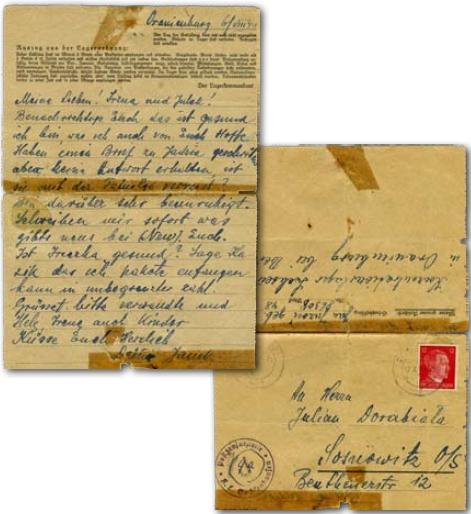just as in the case of the correspondence sent to some camps and POW camps, there are two types of sources, institutional and mixed. The institutional sources of historical personal correspondence, were carried out by the camp authorities and were usually about the prisoners death. The mixed sources were institutional and private and consisted mainly in the POW correspondence. The correspondence was restricted by regulations of the camp, i.e. there was a standard formal character which the letter had to be written in. The camps had separated post offices. Registered prisoners were allowed to send and receive a letter or a postcard every two weeks (a total of 4 postcards). The exception were re-incarcerated prisoners who were entitled to only one letter a month. Restrictions also affected the Jews. Covered by the ban of correspondence were also Soviet POWs, those incarcerated as a result of special SS and Gestapo raids against the Underground movement and those whose families lived in the areas already liberated from German occupation. Such a prohibition could also be introduced by the head office of the camp or by the camp authorities as punishment. Addresses that had been authorized to be the place of recipient could not be altered without the consent of the camp director. To send a letter the prisoner should purchase the paper form and postage in the camp canteen. For this purpose the prisoner could extract money from his deposits – provided of course that had the money on arrival at the camp. If not, he would need a blank form and he could buy a stamp, mostly for bread, from the other prisoners. It occasionally occurred, and so that older prisoners organized form and stamps for the newly arrived prisoners, so they could notify their families of their fate. The correspondence was only allowed in German. The prisoners who did not know German language limited themselves to simple phrases, or depended on the assistance of their German-speaking colleagues. The prisoners were reminded to end their letters with the sentence: “Ich bin gesund und fühle mich gut – “ I’m healthy and feel good.”

The camps used various forms and sheets, and until 1943, in principle, any camp could have its own procedure. Despite their difference, they had several features in common. They all had rules on how to write the letters and the name of the camp. The letters written on a lined paper also featured a rule stating how many words there could be per line. The family’s response had to comply with these guidelines. In 1942, a response to a letter from the camp was filled with clear 15 lines of the letter in German. In 1943, under the uniformed system of letter forms used in the camps was a two-form, ‘sekretnik’. After the submission of half of external sites entered address and the recipient’s name and prisoner of the camp, and the measure was spent on the content of the letter. After folding the ‘sekretnik’ the address of the recipient had to be written on the front page, and also address of the sender and the name of the camp. The content of the letter was written inside the ‘sekretnik’. The ‘sektretnik’ did not have the name of the camp printed on it, it was also half the size of the previously applied form, and had to be filled out with ink, in contrast to the previous form, where the prisoner could use a pencil. If the form was legibly filled out, and did not have any alterations, it was taken by the staff of the block to the office of censorship. Depending on the form, the censors could cut out or cross the suspicious parts and then stamped it with Geprüft ( “verified”). Ticking censored words or sentences were the rule in the procedure of 1943. The amount of correspondence sent and received was recorded in the camp’s record. Posting content deemed dangerous could be investigated and the prisoner punished. The camp’s post office dealt with expedition letters.
